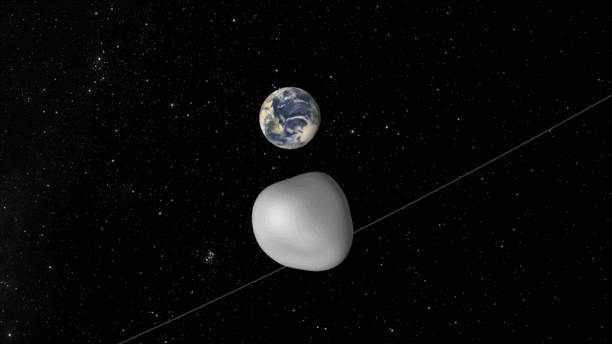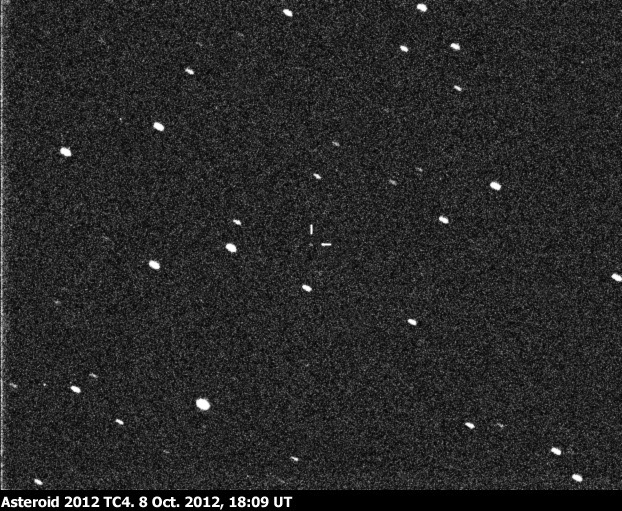A test of NASA’s asteroid defense system
Asteroid 2012 TC4 might give Earth a close shave, or pass more distantly, in October, 2017. Scientists are trying to reacquire the asteroid this summer – find it again in space – to determine its precise orbit.

Illustration of a possible orbit for asteroid 2012 TC4 via Eddie Irizarry.
The Center for Near Earth Object Studies (CNEOS) at NASA’s Jet Propulsion Laboratory in Pasadena, California has had its eye on a small asteroid, designated 2012 TC4, that will pass close to Earth on October 12, 2017. These experts have said that, even though they can’t yet predict exactly how close it’ll come, they’re certain it’ll fly by at a safe distance. That safe distance could be a very close shave, with the space rock passing no closer than 4,200 miles (6,800 km) from our planet. Or it could be a more distant pass, some two-thirds the moon’s distance from Earth. Late in the day on Friday (July 28, 2017), scientists at the University of Arizona (UA) in Tucson, Arizona announced an international collaboration that is utilizing asteroid 2012 TC4 in an exercise to test NASA’s network of observatories and scientists who work with planetary defense.
Paul Chodas, CNEOS’ manager, said:
This is the perfect target for such an exercise because while we know the orbit of 2012 TC4 well enough to be absolutely certain it will not impact Earth, we haven’t established its exact path just yet.

This animation depicts the safe flyby of asteroid 2012 TC4 as it passes under Earth on Oct. 12, 2017. While scientists cannot yet predict exactly how close it will approach, they are certain it will come no closer than 4,200 miles (6,800 km) from Earth’s surface. That’s much farther than, for example, the International Space Station (about 250 miles or 400 km), it’s much closer that many communications satellites in geosynchronous orbits (about 26,000 miles or 40,000 km). Image via NASA/ JPL-Caltech/ UANews.
When we say CNEOS has had its eye on this asteroid, we mean that only figuratively. The calculations on its pass in October, 2017 are based on only seven days of tracking 2012 TC4, shortly after it was discovered in 2012. The Pan-STARRS observatory in Hawaii discovered it on October 5, 2012, and, one week later, the asteroid passed Earth at a distance of only 58,905 miles (94,800 km), or about a quarter of the distance between us and the moon.
Astronomers haven’t seen the asteroid since 2012, because it’s been so distant and so faint. The 2012 observations gave them enough information to put Earth in the clear for the 2017 pass.
However, the lack of further observations hasn’t let scientists precisely define the asteroid’s orbit (although they’re confident there’s no danger of a collision).
In fact, astronomers believe the space rock will more likely pass as far as 170,000 miles (270,000 km), or two-thirds of the Earth-moon distance. If, however, asteroid 2012 TC4 sweeps past us at the closest possible distance, the flyby would be significantly closer than the orbit of TV and other communications satellites, which orbit Earth at 22,300 miles (35,888 km).
How close will it come? That’s what these scientists want to find out, preferably in advance of its closest approach.
The international collaboration described by UA on Friday will help scientists to determine the asteroid’s orbit more precisely. The Lunar and Planetary Laboratory at UA is leading the campaign to reacquire 2012 TC4. In other words, even now, we are not tracking the asteroid; no one has seen it yet on this upcoming approach. Vishnu Reddy, a scientist at UA’s Lunar and Planetary Laboratory, said:
[Reacquiring the asteroid and refining what we know of its orbit] is a team effort that involves more than a dozen observatories, universities and labs across the globe so we can collectively learn the strengths and limitations of our near-Earth object observation capabilities.

Image of asteroid 2012 TC4 from 2012, via G. Masi and F. Nocentini/ Virtual Telescope Project.
Thus as 2012 TC4 starts to approach Earth this summer, large telescopes will be searching for it, with the goal of re-establishing its precise trajectory. The asteroid should become visible again to large ground-based telescopes in early August, scientists say.
The new observations are expected to help refine knowledge about its orbit, narrowing the uncertainty about how far it will be from Earth at its closest approach in October.
Brightness measurements made during the week it was observed in 2012 gave an estimated size of 30 to 100 feet (10 to 30 meters) for asteroid 2012 TC4. That’s comparable to the meteor that caused a shock wave and explosion in Earth’s atmosphere, over the Russian city of Chelyabinsk, in February 2013, injuring 1,500 people and damaging over 7,000 buildings. The Chelyabinsk meteor, before it struck Earth’s atmosphere, is estimated to have been about 20 meters wide.
Astronomers also know that 2012 TC4 is an elongated and rapidly rotating asteroid.
And they know that asteroid 2012 TC4 has made many close approaches to Earth in the past.

Vishnu Reddy of the UA Lunar Planetary Laboratory. “The question is: How prepared are we for the next cosmic threat?” Image via Bob Demers/ UANews.
Bottom line: A small asteroid designated 2012 TC4 will pass Earth safely – but closely – on October 12, 2017. Experts are certain it won’t hit Earth. This summer, an international collaboration of telescopes is trying to reacquire the asteroid – that is, find it again in space – with the goal of precisely determining its orbit.
© 2017 EarthSky Communications Inc.
http://earthsky.org/space/near-earth-asteroid-2012-tc4-close-pass-october-2017
